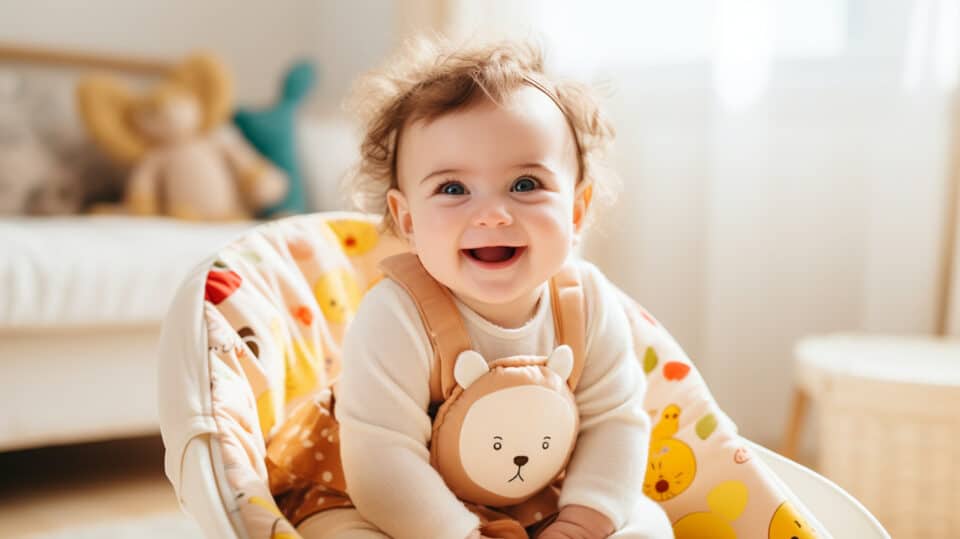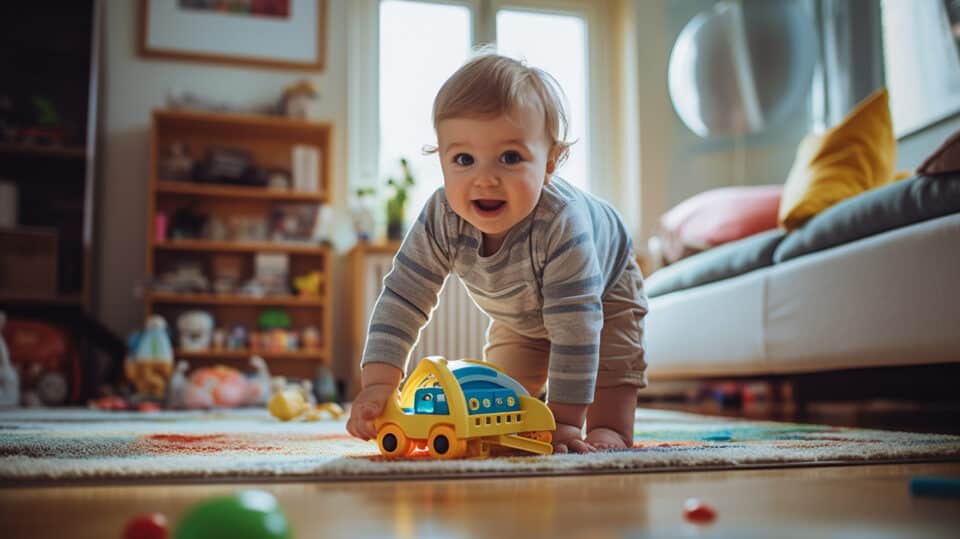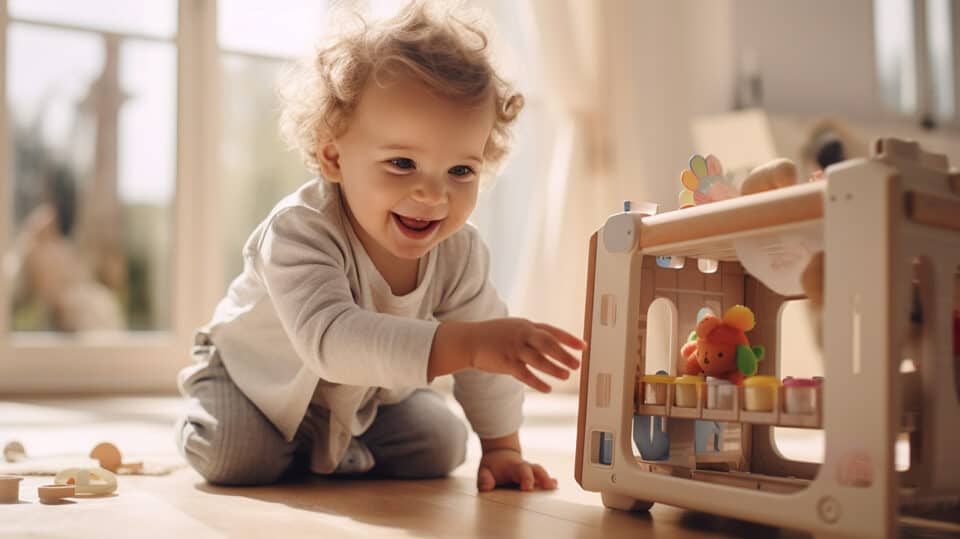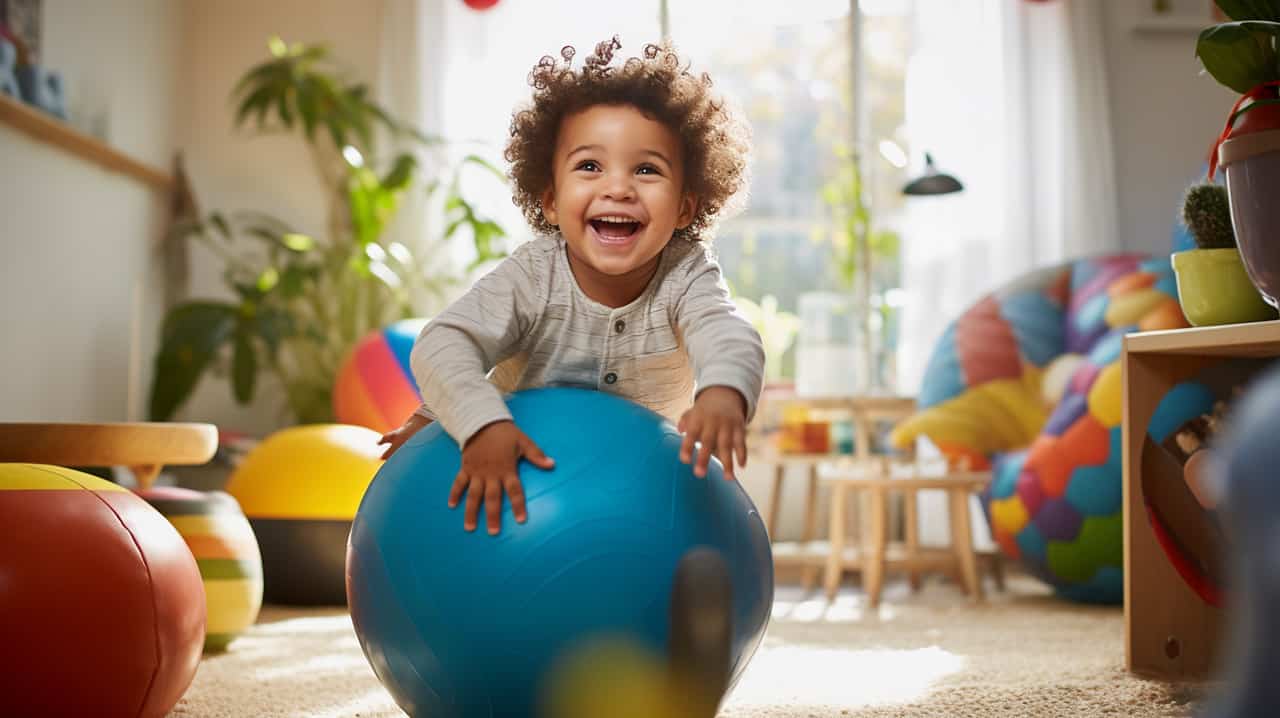Navigating through the sea of baby equipment can leave you feeling overwhelmed as a new mom, especially when it comes to picking the right baby jumper. I’ve been there too and, with research, found out that no two jumpers are made alike, each featuring different benefits but also potential drawbacks.
This article aims to offer you an in-depth guide on what a baby jumper is, its pros and cons, safety measures to take while using one, and suggested alternatives if needed. Let’s dive into our journey toward ensuring your little one jumps safely while having heaps of fun!
Key Takeaways
Baby jumpers are indoor play equipment designed to keep babies entertained and help them develop physical abilities. They use bouncing motions to promote leg muscle growth and pre-walking skills.
There are different types of baby jumpers, including those that attach to a door frame, stationary jumpers with springs suspended from frames, and jumpers with springs beneath the seat.
The benefits of using a baby jumper include promoting leg muscle growth and providing a comfortable seat for babies. However, there are also risks, such as muscle imbalance and foot deformities, if used excessively or without proper supervision.
Safety measures when using a baby jumper include choosing the right one for your child’s age and weight, supervising their usage, setting up in an open space away from hazards, and following the manufacturer’s instructions carefully.
Table of Contents
What is a Baby Jumper?

A baby jumper is essentially a piece of indoor play equipment designed to keep your little one entertained while helping them develop certain key physical abilities. It’s basically a seat securely attached to elastic straps that allows your baby to use their feet to push off the floor and enjoy a bouncing motion.
This can contribute positively to leg muscle growth and enhance pre-walking skills development, making it an exciting aspect of your baby’s routine.
However, not all that glitters with this piece of infant gear is gold. There are potential downsides you need to be aware of as well. The very movements promoted by the use of a baby jumper can trigger a negative impact on the overall movement abilities of infants due to possible muscle imbalances or even foot deformities.
Unexpected mechanical failures in baby jumpers present another risk – head injuries from sudden falls if they ever detach from door frames or other support structures unexpectedly.
Therefore, administering appropriate safety measures and considering all pros and cons before using such equipment becomes absolutely crucial for ensuring optimum safety and health for our precious ones.
Different Types of Baby Jumpers
There are several different types of baby jumpers, including those that attach to a door frame, stationary jumpers with springs suspended from frames, and jumpers with springs beneath the seat.
Baby Jumper that Attaches to a Door Frame
One option to consider when it comes to baby jumpers is the type that attaches to a door frame. As the name suggests, these jumpers clamp onto your door frame and provide an exciting bounce experience for your little one.
With their compact size, they are perfect for small homes or apartments where space is limited.
However, it’s crucial to note potential safety concerns with this type of baby jumper. The biggest concern is if the clamp loosens or detaches from the door frame while in use, resulting in a fall which could cause head injuries.
Verify regularly that everything remains secure during each session, and never leave your child unattended while using this equipment. Safety recommendations suggest not leaving children in jumpers for more than 15-20 minutes per day, as excessive usage can lead to muscle imbalance and foot deformities.
Stationary Baby Jumper with Springs Suspended from Frames
A stationary baby jumper with springs suspended from frames is a fantastic tool for your little one’s playtime. This type of jumper lets your kiddo bounce and move using their legs while still maintaining an upright posture supported by a comfortable seat pad.
You’ll find it becomes something of a joyful workout, improving leg muscle growth and honing pre-walking skills. However, though the safety measures in these jumpers are generally robust, you must always ensure that exposed springs and chains are covered to prevent any finger injuries.
Keep the floor clean, free of tricky areas or objects that can cause tipping over or accidents. It’s essential for baby joy but remember not to let them exceed the baby’s weight limit specified by the manufacturer for optimal safety.
And yes (it’s super important), never leave your angel unsupervised when they’re bouncing away in glee!
Baby Jumper with Springs Beneath the Seat
I personally believe that a baby jumper with springs beneath the seat can be a great option for keeping your little one entertained and active. These types of jumpers provide a bouncing motion that helps strengthen their muscles and develop motor skills.
The springs placed beneath the seat give them a fun and bouncy experience while they play with interactive toys attached to the jumper. However, it’s important to note that medical experts warn about potential risks associated with prolonged use of baby jumpers, such as muscle imbalance and foot deformities.
Therefore, it is crucial to follow safety guidelines and limit usage time to ensure your baby’s healthy growth and development.
The Pros and Cons of Using a Baby Jumper
Using a baby jumper can help promote the growth of leg muscles and develop pre-walking skills, but it may also pose risks such as muscle imbalance and foot deformities. To learn more about the pros and cons of using a baby jumper, continue reading.
Benefits of Baby Jumpers
Baby jumpers offer several benefits for babies. Firstly, they can promote the growth of leg muscles and help develop pre-walking skills. The bouncing movements stimulate these muscles, allowing babies to strengthen their legs and prepare for those first steps.
Additionally, baby jumpers can provide a comfortable seat pad where babies can relax or even sleep. This can be especially helpful for busy moms who need a safe place to keep their little one entertained while they attend to other tasks.
Overall, baby jumpers offer both physical and practical advantages for babies and moms alike.
Risks and Downsides
Using a baby jumper comes with both benefits and risks. On the positive side, baby jumpers can provide entertainment and exercise for your little one, promoting muscle growth and coordination.
However, there are downsides to consider as well. Extended use of baby jumpers can delay a baby’s walking milestone, as it encourages upright posture without fully developing their muscles for crawling or walking.
There is also a risk of falls and head injuries if the jumper malfunctions or if the child jumps too forcefully. Additionally, using a jumper excessively can lead to muscle imbalances and foot deformities in babies.
When Can a Baby Start Using a Jumper?

I started using a baby jumper with my little one when she could hold her head without any support, which was around three to six months of age. It’s important to wait until your baby has developed sufficient neck and upper body strength before introducing them to a jumper.
This ensures that they can safely bounce and play without any risk of injury. Experts recommend not starting too early as it may strain the baby’s neck and back muscles. So make sure your little one is ready before letting them enjoy the fun and excitement of a baby jumper!
Safety Tips for Using a Baby Jumper

When using a baby jumper, it is important to choose the right one for your child’s age and weight, ensure proper timing and supervision during use, use the jumper in an open space away from any potential hazards, and always adhere to the manufacturer’s instructions.
Choosing the Right Jumper
When choosing a baby jumper, it’s important to consider the safety and comfort of your little one. Look for a jumper that has a comfortable seat pad with good neck support to keep your baby secure while they bounce.
Make sure the jumper has adjustable straps so you can customize the height as your baby grows. It’s also helpful to choose a jumper that offers different play options, such as attractive toys or music, to keep your baby entertained.
Always check the weight limit of the jumper to ensure it is suitable for your baby’s size and age. And finally, don’t forget to read and follow the manufacturer’s instructions carefully for proper setup and usage guidelines.
Timing and Supervision
It’s crucial to consider the timing and supervision when using a baby jumper. Experts recommend waiting until your little one can hold their head without support, typically around three to six months of age, before introducing them to a jumper.
Additionally, it’s important to supervise your baby while they’re in the jumper to ensure their safety and prevent any accidents. Keeping an eye on them allows you to respond quickly if any issues arise and provide peace of mind for both you and your little one.
So be sure to choose the right time for your baby’s developmental stage and always keep a watchful eye when they’re enjoying their time in the jumper.
Using the Jumper in an Open Space
To ensure your baby’s safety while using a jumper, it’s important to set it up in an open space. This allows for more freedom of movement and reduces the risk of bumping into furniture or walls.
It’s also essential to make sure the floor is clean and free from any hazards that could cause injury. Avoid using the jumper near stairs or pools, as they pose significant dangers.
By providing a safe and spacious area, you can give your little one the opportunity to bounce and play freely while keeping them protected from potential accidents.
Adhering to Manufacturer’s Instructions
It is crucial to follow the manufacturer’s instructions when using a baby jumper to ensure your baby’s safety. These instructions provide important guidelines for proper installation, weight limits, and usage recommendations.
By adhering to these instructions, you can minimize any potential risks and create a safer environment for your little one. Remember that each baby jumper may have specific requirements and precautions, so take the time to read and understand the instructions thoroughly before setting up the jumper.
This will help you make informed decisions regarding the appropriate use of the equipment and keep your baby safe while they enjoy their jumping adventures!
Alternatives to Baby Jumpers

Here are some popular baby jumper alternatives for your soon-to-be-walking little one!
- Stationary activity centers provide a safe and interactive space for babies to play, with features like spinning seats, toys, and music.
- Activity gyms offer a variety of sensory stimulation through hanging toys, mirrors, and textures for babies to explore while lying on their backs or bellies.
- Baby push walkers can help promote balance and walking skills when the baby is ready to take those first steps.
Read on to discover more about these alternatives and find the best option for your little one’s development!
Stationary Activity Center
A great alternative to baby jumpers is a stationary activity center. This type of equipment provides a safe and secure space for your little one to play and explore. Stationary activity centers usually have a comfortable seat pad with attractive toys attached, allowing your baby to engage in different activities while building their motor skills.
Unlike baby jumpers, stationary activity centers are designed to keep your baby in an upright position, promoting proper spine and muscle development. Plus, they eliminate the risk of falling out or detaching from door frames, as some baby jumpers do.
It’s important to remember that using any type of equipment should be done under adult supervision and for short periods of time to ensure your baby’s safety and optimal growth.
Activity Gyms
Activity gyms are a great alternative to baby jumpers. They provide a safe and stimulating environment for your little one to play and explore. Activity gyms typically have soft, colorful mats with interactive toys hanging overhead.
These toys encourage reaching, grasping, and kicking, promoting the development of fine motor skills. Additionally, activity gyms usually come with different textures and sounds that engage your baby’s senses.
They also offer tummy time support, which is crucial for strengthening neck and back muscles. Not only are activity gyms entertaining for babies, but they also allow them to learn through play while staying safe on a secure surface.
Baby Push Walkers
Baby push walkers are a great alternative to baby jumpers when it comes to helping your little one with their first steps. They provide support and stability for standing or cruising babies, allowing them to practice walking while still being able to hold on for balance.
Unlike baby jumpers, which can potentially delay developmental milestones like walking if used excessively, push walkers encourage your baby’s natural motor development. They also help strengthen their leg muscles and promote trunk control.
With the right design and safety features, baby push walkers can be a fun and effective tool in assisting your child’s journey toward independent movement.
Frequently Asked Questions About Safe Baby JUmper Use
Are baby jumpers safe for my child?
Baby jumpers can be safe when used properly and with proper supervision. It is important to follow the manufacturer’s guidelines, ensure a secure attachment to door frames or other supports, and always monitor your child while they are using a jumper.
At what age can my baby start using a jumper?
Most manufacturers recommend waiting until your baby is able to hold their head up independently and has good control of their upper body before introducing them to a jumper. This typically occurs around 4-6 months of age, but it is important to consult with your pediatrician for specific recommendations based on your child’s development.
What are the benefits of using a baby jumper?
Using a baby jumper can provide several benefits for your little one. It promotes muscle strength and coordination as they bounce and use their legs, helps develop balance and spatial awareness, provides entertainment and stimulation, and can give caregivers some hands-free time while keeping the baby entertained.
How long should my baby use a jumper each day?
It is generally recommended not to exceed 20 minutes of continuous use in a jumper at once due to the potential strain on developing muscles and joints. However, every child is different, so it’s best to observe how your baby responds during playtime sessions in the jumper and adjust accordingly based on their comfort level.
Conclusion
In conclusion, baby jumpers can be a fun and entertaining activity for babies. They provide a way for infants to exercise their leg muscles and develop their pre-walking skills. However, it is important to use them in moderation and follow safety guidelines to prevent any potential risks or injuries.
Remember, always prioritize your baby’s safety and consult with pediatric experts for further recommendations on using baby jumpers.


